Maguro Explained: Types of Tuna and Different Cuts

The fish used to make sushi at restaurants in Japan are often a mystery to foreign visitors. Why are there so many types of tuna? This article explains the varieties of cuts from bluefin tuna, or maguro, which is a basic ingredient for sushi.
What's in Your Sushi?

Japan has a multitude of delicious fish dishes, with sushi and sashimi, being two of the most popular ones. Foreign visitors often run into the problem that it is difficult to distinguish between different kinds of fish and fish dishes.
It is not unusual for the same type of fish to have different names depending on the dish it is used in, the way it is cut, or the method of cooking.
In this article, we will provide an in-depth explanation about bluefin tuna and it's different names.
Read also
Each Part of the Tuna Has a Different Name

Bluefin tuna, also known as maguro in Japanese, is very large. It is a Japanese tradition that not a single part from head to tail is wasted. The taste, the price, and the name of the cut vary according to the body part it is from. Let’s introduce those cuts here.

The Head is separated into the flesh of the upper head, the cheek, the jaw and the eyes.
Kabutoyaki, a dish with serious visual impact, is a bluefin tuna head cooked as a whole. The flesh from the top of the head is called kashiraniku, a rare cut that comprises just 0.5% of the tuna.
The taste of the cheek flesh is simple, but many people enjoy the meaty texture.
Kama or Kamatoro refers to the gill flesh, and there are only two pieces that can be cut from each tuna. The particularly fatty part within the kama is called kamatoro. The flesh’s rich fat content makes it look almost exactly like a section of marbled beef.
Kama is eaten in many different ways, such as barbecues and stews, while kamatoro is made into sashimi and sushi. Kamatoro is also used as an ingredient in high-class shabu-shabu.
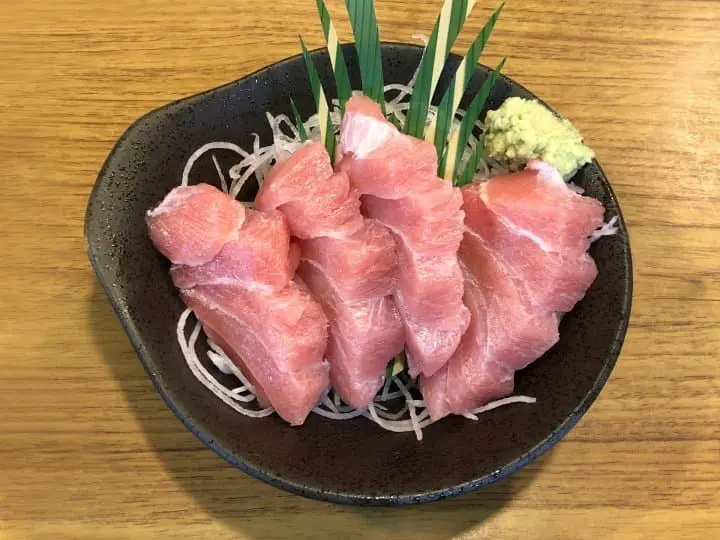
Otoro is the name of the fattiest part of a tuna. Otoro has a characteristic sophisticated taste and a distinctive fat marbeling which makes the pieces to melt in your mouth.
The area on the abdomen near the gills is called harakami, and the center of the abdomen is called haranaka. Otoro is located between the harakami and haranaka.
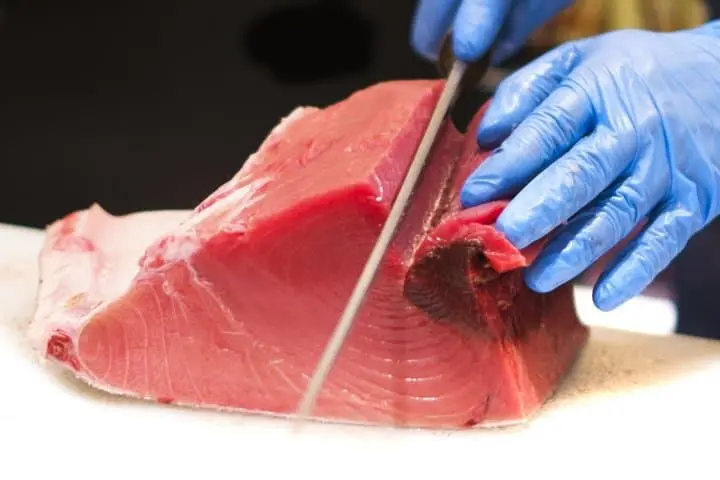
Chutoro refer to parts of the tuna that can be found on both the back and stomach of the fish. More specific, the part of the back close to the head is sekami, the center of the back is called senaka, and the part closest to the tail is seshimo. The section of the haranaka close to the tail is called harashimo is also part of chutoro.
While not as rich as otoro, chutoro has a moderate fattiness and a can be enjoyed for a reasonable price, which makes it a very popular cut.

Akami is the name for the center of the tuna’s body. This cut has the least fat out of the whole fish, which makes it the most affordable. If you don’t really like fatty tuna, we recommend that you try akami.
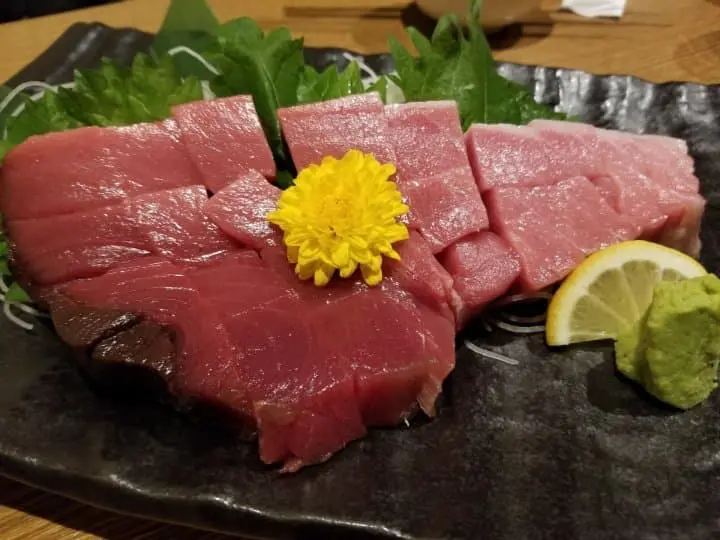
The tail of the tuna is rich in fat, which gives it a concentrated flavor. Like kama, the tail is usually made into steaks, barbecued, or used in stews.
Different Types of Tuna, Different Prices
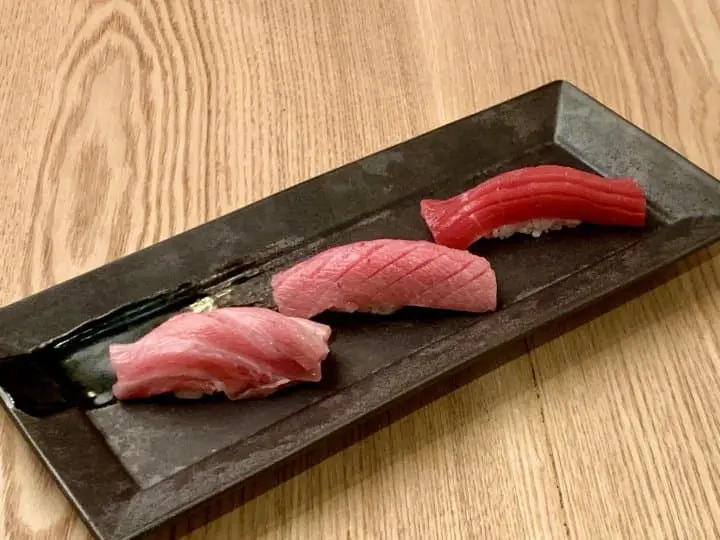
Five different varieties of tuna are sold in Japan. Each one has a different price and flavor profile.
The five kinds are northern bluefin (honmaguro), southern bluefin (minamimaguro), bigeye (mebachimaguro), yellowfin (kihadamaguro) and albacore (binnagamaguro). The prices can not only vary depending on the kind but also on other factors, such as whether it was caught in the wild or bred on a fish farm or if it has been frozen.
Northern bluefin tuna from the ocean is one of the most expensive variations. Prices fluctuate because the number of fish caught is more affected by climate conditions, compared to the volume of fish raised on fish farms.
Where the tuna is caught also influences the cost. A hundred-gram cut of northern bluefin tuna from the famous Oma brand, caught in the ocean, can cost up to 2,500 yen, while the same cut from a tuna caught overseas can cost up to 1,900 yen.
Farmed tuna is amongst the cheapest. A hundred-gram cut of northern bluefin tuna from a fish farm around Japan will cost up to 1,200 yen. Ocean-caught, farmed and frozen tuna can be delivered fresh to your door via online shopping, which is quite convenient!
Prices for tuna sushi at places like conveyor-belt sushi restaurants are very reasonable! While prices depend on the cut, you can enjoy one plate of tuna topped sushi for as cheap as 100 yen.
Enjoy Japan's Delicious Tuna
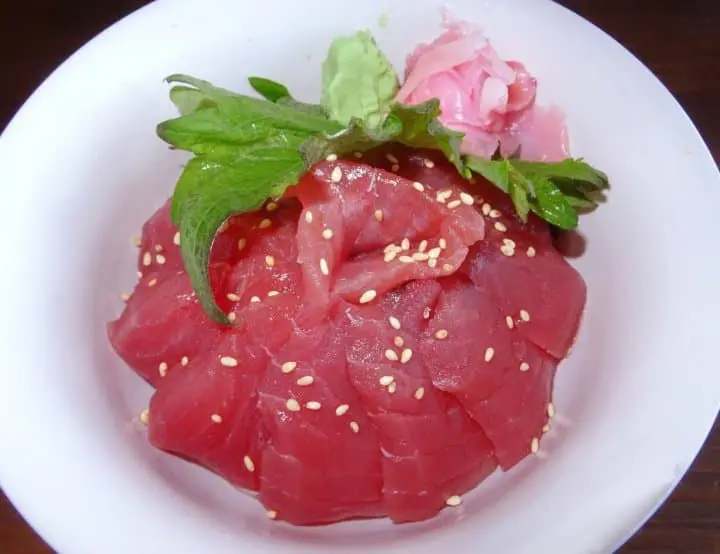
While taking your budget and preferences into consideration, why not challenge yourself by trying out all sorts of tuna cuts and dishes? You will not regret it!
*These prices are a rough estimate.
FAQ
What kind of fish is maguro?
Maguro is the Japanese term for tuna, specifically the bluefin tuna. In Japanese cuisine, maguro is a highly prized and commonly consumed type of fish that is popular for its rich flavor and versatile use in various dishes such as sushi, sashimi, and grilled preparations. Bluefin tuna, including varieties like the "hon-maguro" (bluefin tuna) and "mebachi-maguro" (bigeye tuna), are highly sought after for their taste and texture. The different cuts of maguro have varying qualities and are enjoyed in traditional and contemporary Japanese culinary creations.
What is maguro sushi?
Maguro sushi refers to sushi that features tuna (maguro) as the primary ingredient. It typically consists of a piece of vinegared rice (shari) topped with a slice of fresh raw tuna. Maguro sushi is a popular and iconic dish in Japanese cuisine, enjoyed for its rich flavor and buttery texture. There are different types of tuna commonly used for maguro sushi, including akami (lean red tuna), chutoro (medium fatty tuna), otoro (fatty tuna), and maguro varieties such as hon-maguro (bluefin tuna) and mebachi-maguro (bigeye tuna). Maguro sushi can be served by itself or as part of assorted sushi platters, offering a delightful taste of this prized seafood in a traditional Japanese culinary style.
Is maguro expensive?
Maguro, or tuna, comes in various grades and cuts that impact its price. High-quality varieties like otoro and bluefin tuna are considered luxurious and expensive due to their prized taste and texture, with prices often reaching hundreds to thousands of dollars per pound. However, more affordable options like lean tuna (akami) exist, offering a range of choices to accommodate different budgets. Despite the potential expense of premium maguro cuts, there are options available at various price points to suit a wide range of tastes and financial considerations in the world of Japanese cuisine.
What is the difference between maguro and toro?
In the realm of tuna cuts, "maguro" encompasses a spectrum of choices including the lean akami, the balanced chutoro, and the prized fatty otoro known for its luxurious marbling and melt-in-your-mouth texture. On the other hand, "toro" serves as a broad category highlighting the fatty sections of tuna, incorporating both chutoro and the esteemed otoro. Toro captures the essence of richness and tenderness in tuna cuts, with otoro standing out as the pinnacle of indulgence due to its high fat content and exceptional quality, making it a sought-after delicacy in Japanese cuisine.
What is the most expensive tuna?
Bluefin tuna, particularly the Pacific bluefin species, is renowned as the most expensive type of tuna. Among its cuts, otoro, harvested from the fattiest part near the belly, stands out as exceptionally prized, known for its buttery texture and rich flavor. At auctions like those in Japan's Tsukiji or Toyosu Markets, bluefin tuna, especially premium cuts like otoro from large fish, can fetch exorbitant prices, often reaching hundreds of thousands to millions of dollars due to its limited supply, high demand, and exceptional quality.
Can you eat maguro raw?
Yes, maguro, which refers to tuna in Japanese cuisine, can be eaten raw. In fact, raw tuna is a key ingredient in popular Japanese dishes like sushi and sashimi. Tuna used for these dishes is typically handled and prepared with care to ensure freshness and safety for consumption. Various types of tuna cuts, such as akami (lean tuna), chutoro (medium fatty tuna), and otoro (fatty tuna), are commonly served raw in sushi restaurants. When consuming raw maguro or any raw seafood, it is essential to ensure that it has been properly sourced, handled, and stored to minimize the risk of foodborne illnesses.
日本への訪日外国人の方が、もっと増えますように!

































![[Coupon Available] Attention Overseas Winter Sports Fans! Nagano's Sports Depot Has Evolved](https://resources.matcha-jp.com/resize/720x2000/2026/01/05-254819.webp)
![[2 hours from Tokyo ] 10 Quiet and Breathtaking Views of Mount Fuji in Yamanashi Hokuto City , Yamanashi - Part 2](https://resources.matcha-jp.com/resize/720x2000/2025/12/16-253037.webp)
